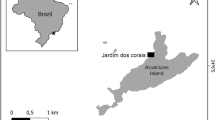Abstract
The relative abundance of bacteria in the mucus and tissues of Oculina patagonica taken from bleached and cave (azooxanthellae) corals was determined by analyses of the 16S rRNA genes from cloned libraries of extracted DNA and from isolated colonies. The results were compared to previously published data on healthy O. patagonica. The bacterial community of bleached, cave, and healthy corals were completely different from each other. A tight cluster (>99.5% identity) of bacteria, showing 100% identity to Acinetobacter species, dominated bleached corals, comprising 25% of the 316 clones sequenced. The dominant bacterial cluster found in cave corals, representing 29% of the 97 clones sequenced, showed 98% identity to an uncultured bacterium from the Great Barrier Reef. Vibrio splendidus was the most dominant species in healthy O. patagonica. The culturable bacteria represented 0.1–1.0% of the total bacteria (SYBR Gold staining) of the corals. The most abundant culturable bacteria in bleached, cave, and healthy corals were clusters that most closely matched Microbulbifer sp., an α-proteobacterium previously isolated from healthy corals and an α-protobacterium (AB026194), respectively. Three generalizations emerge from this study on O. patagonica: (1) More bacteria are associated with coral tissue than mucus; (2) tissue and mucus populations are different; (3) bacterial populations associated with corals change dramatically when corals lack their symbiotic zooxanthellae, either as a result of the bleaching disease or when growing in the absence of light.
Similar content being viewed by others
References
Altschul SF, Gish W, Miller W, Meyers EW, Lipman DJ (1990) Basic local alignment search tool. J Mol Biol 215:403–410
Anthony KRN, Hoegh-Guldberg O (2003) Variation in coral photosynthesis, respiration and growth characteristics in contrasting light microhabitats: an analogue to plant in forest gaps and understoreys? Funct Ecol 17:246–259
Bourne DG, Munn CB (2005) Diversity of bacteria associated with the coral Pocillopora damicornis from the Great Barrier Reef. Environ Microbiol 7:1162–1174
Bourne DG (2005) Microbial assessment of a disease outbreak on corals from Magnetic Island (Great Barrier Reef, Australia). Coral Reefs 24:304–312
Ducklow HW, Mitchell R (1979) Bacterial populations and adaptations in the mucus layers on living corals. Limnol Oceanogr 24:715–725
Fine M, Loya Y (2004) Coral bleaching in a temperate sea: from colony physiology to population ecology. In: Rosenberg E, Loya Y (eds) Coral health and disease. Springer, Berlin New York, pp 143–156
Fine M, Loya Y (2002) Endolithic algae: an alternative source of photoassimilates during coral bleaching. Proc R Soc Lond B Bio 269:1205–1210
Fine M, Oren U, Loya Y (2002) Bleaching effect on regeneration and resource translocation in the coral Oculina patagonica. Mar Ecol Prog Ser 234:119–125
Koren O, Rosenberg E (2006) Bacteria associated with mucus and tissues of the coral Oculina patagonica in summer and winter. Appl Environ Microbiol 72:5254–5259
Kushmaro A, Loya, Fine M, Rosenberg E (1996) Bacterial infection and coral bleaching. Nature 380:396–96
Lane DJ (1991) 16S/23S rRNA sequencing. In: Stackebrandt E, Goodfellow M (eds) Nucleic acid techniques in bacterial systematics. Wiley, Chichester, UK, pp 115–175
McGrath T, Smith WG (1999) Community shifts in the surface mucopolysaccharide layer microbiota of Agaricia sp. during the 1995/6 and 1998/9 bleaching events on patch reefsof San Salvador Island, Bahamas. In: 29th meeting of the Association of Marine Laboratories of the Caribbean, Cumana, Venezuela, July
Noble RT, Fuhrman JA (1998) Use of SYBR Green I for rapid epifluorescence counts of marine viruses and bacteria. Aquat Microb Ecol 14:113–118
Reshef L, Koren O, Loya Y, Zilber-Rosenberg I, Rosenberg E (2006) The coral probiotic hypothesis. Environ Microbiol 8:2068–2073
Ritchie KB, Smith WG (1995) Carbon-source utilization of coral-associated marine heterotrophs. J Mar Biotechnol 3:107–109
Ritchie KB, Smith WG (1997) Physiological comparisons of bacterial communities from various species of scleractinian corals. Proc 8th Int Coral Reef Symp 1:521–526
Ritchie KB (2006) Regulation of microbial populations by coral surface mucus and mucus-associated bacteria. Mar Ecol Prog Ser 322:1–14
Rohwer F, Kelley S (2004) Culture-independent analyses of coral-associated microbes. In: Rosenberg E, Loya Y (eds) Coral health and disease. Springer, Berlin New York, pp 265–277
Rohwer F, Breitbart M, Jara J, Azam F, Knowlton N (2001) Diversity of bacteria associated with the Caribbean coral Monastrea franksi. Coral Reefs 20:85–91
Rosenberg E, Falkovitz L (2004) The Vibrio shiloi/Oculina pagagonica model system of coral bleaching. Ann Rev Microbiol 58:143–159
Rosenberg E, Koren O, Reshef L, Efrony R, Zilber-Rosenberg I (2007) The role of microorganisms in coral health, disease and evolution. Nature Rev Microbiol 5:355–362
Schloss PD, Handelsman J (2005) Introducing DOTUR, a computer program for defining operational taxonomic units and estimating species richness. Appl Environ Microbiol 71:1501–1506
Shashar N, Cohen Y, Loya Y, Sar N (1994) Nitrogen fixation (acetylene reduction) in stony corals: evidence for coral–bacteria interactions. Mar Ecol Prog Ser 111:256–264
Thompson JD, Gibson TJ, Plewniak F, Jeanmougin F, Higgins DG (1997) The ClustalX windows interface: flexible strategies for multiple sequence alignment aided by quality analysis tools. Nucleic Acids Res 24:4876–4882
Yachi S, Loreau M (1999) Biodiversity and ecosystem productivity in a fluctuating environment: the insurance hypothesis. PNAS 96:1463–1468
Zibrowius H (1974) Oculina patagonica, scleractiniaire hermatypique introduit em Mediterranee. Helg Wiss Meeresunters 26:153–173
Acknowledgments
This research was supported by grants from the Israel Center for the Study of Emerging Diseases, the World Bank Coral Disease and Bleaching Groups, and the Pasha Gol Chair for Applied Microbiology.
Author information
Authors and Affiliations
Corresponding author
Rights and permissions
About this article
Cite this article
Koren, O., Rosenberg, E. Bacteria Associated with the Bleached and Cave Coral Oculina patagonica . Microb Ecol 55, 523–529 (2008). https://doi.org/10.1007/s00248-007-9297-z
Received:
Revised:
Accepted:
Published:
Issue Date:
DOI: https://doi.org/10.1007/s00248-007-9297-z




